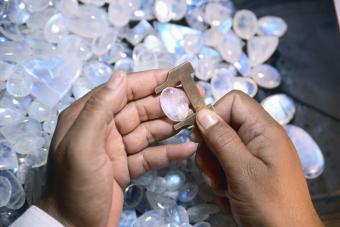
Moonstones, with their shimmery inner reflections, have captivated people for centuries, yet they aren't as well-remembered as stones like diamonds, emeralds, and rubies. Over the years, healing properties, love spells, and clairvoyance have been connected with this gemstone. If you aren't already fascinated with this ethereal gem, check out these moonstone facts that are sure to blow you away.
Metaphysical Moonstone Symbolism

Energetically, moonstone is closely connected to moon energy. Likewise, it has strong links to water energy, just as the moon does with the tides. Along with water energy, this stone has been known to have an affinity for those who're astrological water signs. Depending on their coloring, moonstones can have other specified characteristics. For example, the silver moonstone encourages harmony and peace within the owner, and peach moonstones help instill confidence in the wearer. No matter its color, every moonstone if placed under the pillow will help you get a good night's rest. Some other examples of moonstone's metaphysical attributes include:
- Balancing yin and yang
- Balancing emotions by connecting the pineal gland and the 2nd and 6th chakras
- Stimulating intuition
- Increasing dream activity
- Assisting in embracing fear
Color and Meaning

In terms of coloring, moonstones are translucent with a sheen that resembles pearls and opals. The gems come in a variety of colors including white, gray, peach, pink, yellow, blue, and green. Some types are completely transparent, while others are entirely colorless. The most popular type of moonstone is the rainbow moonstone, which is an iridescent white or gray with a blue sheen in the light, and the highest quality examples of these stones have a really present shimmer. Each moonstone color is associated with a different meaning:
- White - Associated with its ability to resolve nightmares and insomnia
- Peach - Connected to love, confidence, and self-esteem
- Blue - Creates balance between yin and yang energies. Provides clarity of the mind
- Green - Promotes relaxation and connectivity with nature; said to promote prosperity
- Gray - Indicator of new beginnings; rare and mysterious color variation of the stone
Historic Folklore Surrounding Moonstones
Moonstone lore is cross-cultural, spanning the European continent, parts of Asia, and the Americas. The folklore surrounding the stone depends on both culture and continent.
- The ancient Greeks called the gem Aphroselene in honor of the goddesses Aphrodite and Selene, while the Romans claimed the goddess Diana could be seen in every moonstone. Both the Romans and Greeks believed that this stone had ties to the moon.
- Some ancient Asians believed the gem was a solid ray of moonlight filled with good spirits, and moonstones in India were revered as a symbol of the third eye.
- By the Medieval period, Europeans had adopted moonstones into their mystical arts and gazed into them to invoke prophetic dreams.
Historic Meaning of Moonstone

Known as a talisman for protection, health, and good fortune, moonstone was once called the traveler's stone and was used to increase protection on harrowing journeys. Many people believed that the gem calmed anxiety and promoted harmonious relationships. While some groups of people clung to moonstone's mystical symbolism, such as its connection to growing abundant harvests and predicting the future by holding a moonstone in your mouth and looking at a full moon, a majority of people connected the delicate, angelic stone to love and conventional femininity. In fact, there was a belief that two people could fall passionately in love if they gazed upon one another while wearing a moonstone under a full moon. Most recently, moonstones have been linked to the month of June as they're considered one of June's three birthstones alongside pearls and alexandrite.
Moonstone's Healing Properties
Moonstones are often incorporated in healing therapy because they're linked with having strong health properties, particularly those associated with menstrual cycles and pregnancy. It's important to note there is no existing scientific evidence to back these claims. However, a small group of people continue to use moonstones for their healing qualities, and some of the ailments that they use moonstones to alleviate include:
- Reducing stress or anxiety
- Treating female hormone imbalance
- Mollifying menstrual problems
- Relieving premenstrual syndrome
- Increasing fertility
- Enhancing libido
- Preventing epileptic seizures
- Curing digestive issues
- Riding the body of toxins
- Getting rid of headaches
- Preventing sunstroke
- Stopping a nose bleed
Interesting Moonstone Facts
Moonstone is indeed interesting to gaze upon, but the powerful, pretty magical stone is also interesting to learn about. These moonstone facts will aid in deepening your knowledge of this stunning stone.
- The most popular piece of moonstone jewelry, the Iris Moonstone Necklace, resides at the Smithsonian National Museum of Natural History in Washington. It contains a marquise-cut central moonstone, a one-of-a-kind cat's eye effect, and a notable inscription on the back that reads: "By the light of a silver moon an ocean of life awaits your magical touch."
- The rarest and most expensive moonstones are colorless and contain a floating blue color or schiller.
- Many claim moonstones must be charged, much like a cell phone, except moonstones are charged via lunar light.
- The moonstone became the Florida State Gemstone during the 1970s space exploration movement to honor the Kennedy Space Center and NASA's achievements.
Moonstone Mining and Characteristics
All gemstones have their own unique set of origins and characteristics, and the moonstone is no different in this respect. It's a rare and beautiful, almost haunting, stone that is full of meaning and mythology.
Moonstone Origins
Despite the original belief that moonstones fell from the sky, scientists have confirmed that the natural stone does indeed come from the earth and is commonly found in Sri Lanka, Brazil, Madagascar, India, Germany, Tanzania, Mexico, Australia, and the United States. The finest specimens have been located in Sri Lanka and India.
Moonstone Makeup
A member of the orthoclase feldspar mineral family, this gemstone is a combination of potassium aluminum silicate and gets its shimmery quality from the crystal structures present within the stones. This shimmer effect is called adularescence, and to enhance this adularescence, jewelers often cut these stones into a smooth cabochon shape.
Difference Between Moonstone and Labradorite
Moonstone and labradorite are similar stones especially in regards to appearance, but they are certainly not the same. Differences primarily lie within the makeup of the stone itself.
- Labradorite is comprised of plagioclase feldspar calcium and sodium.
- Moonstone is, by contrast, a mineral of the orthoclase feldspar group. It is composed of potassium aluminum silicate.
- Moonstones will refract less light than a labradorite stone.
- When it comes to price, moonstone is generally more expensive and less commonly found.
Tips for Keeping and Cleaning Moonstones
Moonstones are rather soft, ranking only at a 6-6.5 out of 10 on the Mohs hardness scale; therefore, there are a few extra steps of precaution you can take when caring for your loose moonstones or moonstone jewelry to protect them from preventable damage. Secure your moonstones either individually wrapped in soft cloth or jewelry bags if you're not storing them in velvet/felt-lined jewelry boxes. Make sure to keep your stones away from much harder gems like rubies, sapphires, and diamonds as these can easily mar the stone's adularescent surface.
When it comes to cleaning your moonstones, stay away from ultrasonic or steam cleaners as these can significantly damage your stone's integrity and appearance. Gently washing your moonstones with a mild soap and water mixture should keep them free from the daily build-up of dirt and grime. However, if you're finding a stubborn spot that you can't clean on your own, you can always take your stones to a professional jeweler to have them both clean and polish your pieces.
Femininity and Mysticism Personified
Given humanity's history of diminishing and patronizing femininity, it's incredible to see a few of the ways that femininity was reclaimed through mysticism and the natural arts as it manifested in natural materials likes moonstones. Whether you're trying to access your dreams more easily or just want something beautiful to rest against your collarbone, moonstones can be a lustrous addition to your collections.







